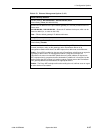
4. Configuration Options
9128-A2-GB20-80 September 2002
4-89
NMS
n
IP Address
Possible Settings: 001.000.000.000 – 223.255.255.255, Clear
Default Setting: Clear (000.000.000.000)
Specifies the IP address that identifies the SNMP manager(s) to receive SNMP traps.
Display Conditions
– This option appears for each trap manager specified in the
Number of Trap Managers configuration option.
001.000.000.000 – 223.255.255.255 – Adds to or changes the IP address for the trap
manager.
Clear – Fills the NMS IP address with zeros.
Initial Route Destination
Possible Settings: AutoRoute, Modem, COM, Ethernet,
PVCname
Default Setting: AutoRoute
Specifies the initial route used to reach the specified Trap Manager. When proprietary RIP
is active, only one unit in the network needs to specify an interface or management link as
the initial destination. All other units can use the default setting.
Display Conditions
– This option appears for each trap manager specified in the
Number of Trap Managers configuration option.
AutoRoute – Uses proprietary RIP from other FrameSaver devices to learn the route for
sending traps to the specified Trap Manager, or the Default IP Destination when no route
is available in the routing table (see Table 4-17, Node IP Options).
Modem – Uses the Modem port. This selection only appears if the Modem Port Use
configuration option is set to Net Link (see Table 4-25, Modem Port Options).
COM – Uses the COM port. This selection is only available when Port Use is set to Net
Link (see Table 4-24, Communication Port Options).
Ethernet – For the FrameSaver SLV 9126-II or 9128-II, uses the Ethernet port. Only
appears when the Ethernet port’s Interface Status option is enabled (see Table 4-23,
Ethernet Management Options).
PVCname
– Uses the defined management
linkname
(the name given the Management
PVC). This selection only appears when at least one Management PVC is defined for the
node.
General Traps
Possible Settings: Disable, Warm, AuthFail, Both
Default Setting: Both
Determines whether SNMP trap messages for warmStart and/or authenticationFailure
events are sent to the currently configured trap manager(s). An authenticationFailure trap
indicates that the unit is the addressee of an SNMP protocol message, or an incoming
ISDN call is not properly authenticated.
Disable – Does not send trap messages for these events.
Warm – Sends trap messages for warmStart events only.
AuthFail – Sends trap messages for authenticationFailure events only.
Both – Sends trap messages for both warmStart and authenticationFailure events.
Table 4-22. SNMP Traps and Trap Dial-Out Options (2 of 6)


















